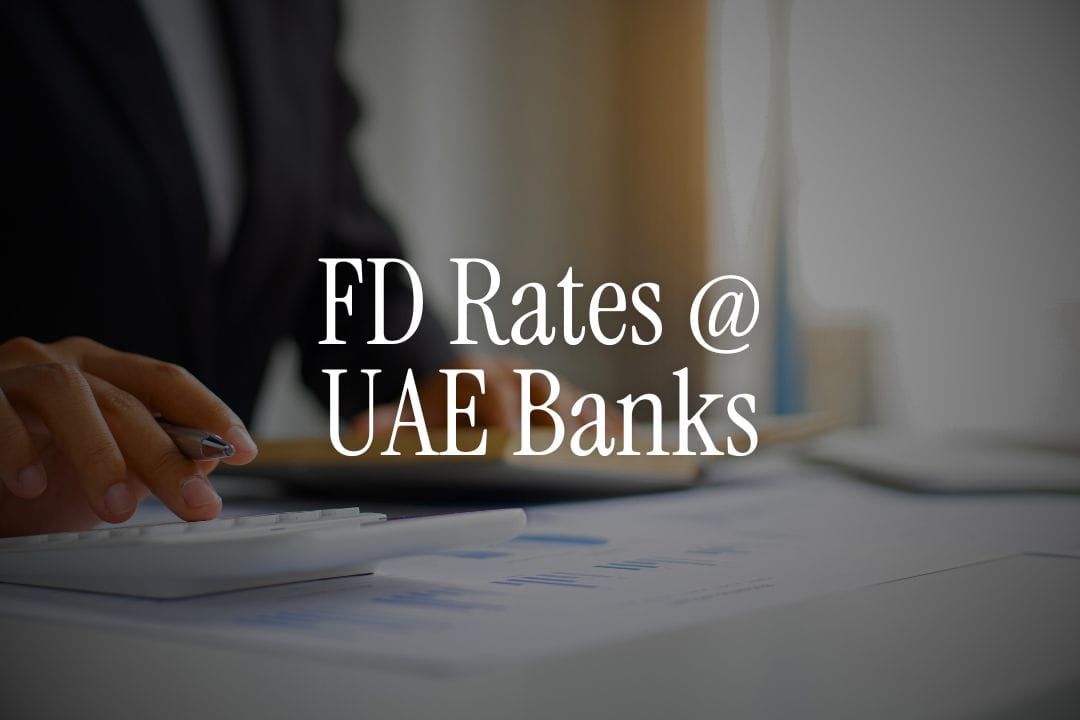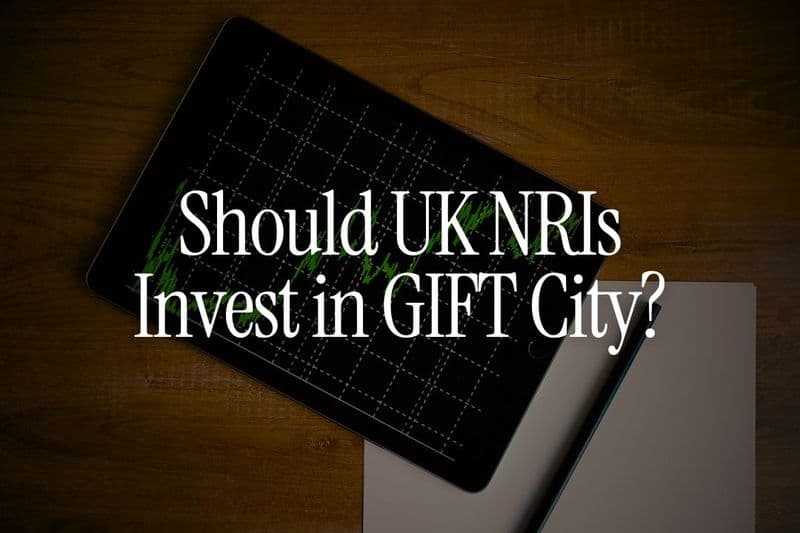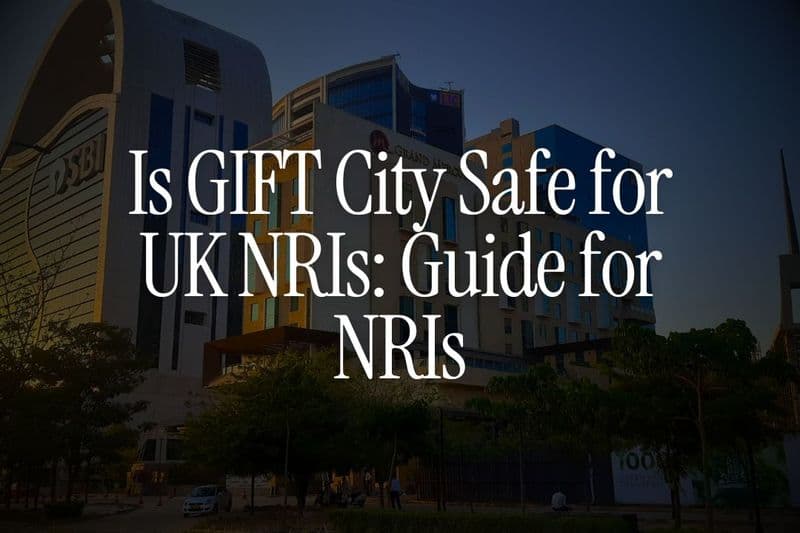
Living in Dubai with your salary in AED, you’re weighing options: a UAE fixed deposit at 3%, an Indian FD at 7%, or GIFT City USD deposits for tax-free returns?
Colleagues praise Emirates NBD, family suggests RAKBank, and online groups mention Dubai Islamic Bank’s 3.30% profit rate..
Your financial advisor pushes for India’s higher rates. After 12 years guiding NRIs at Belong, we have seen this dilemma often. There’s no one-size-fits-all answer-it depends on your goals, timeline, and risk tolerance.
This guide compares FD rates from top UAE banks (Emirates NBD, FAB, ADCB, Mashreq, RAKBank, DIB, ADIB, Commercial Bank International), Indian NRE FDs, and GIFT City deposits, covering taxation and currency risks to help you maximize your savings.
Current UAE Fixed Deposit Rates (October 2025)
Let's start with the numbers. Here's what major UAE banks are offering right now.
Bank | Best AED Rate | Best Tenure | Minimum Deposit | Type |
|---|---|---|---|---|
Dubai Islamic Bank (DIB) | 3.30% | 12 months | AED 25,000 | Islamic (Profit-based) |
Mashreq Bank | 2.00% | 12 months | AED 10,000 | Conventional |
RAKBank | 3.25% | 12 months | AED 25,000 | Conventional |
First Abu Dhabi Bank (FAB) | 2.34% | 12 months | AED 10,000 | Conventional |
ADCB | 2.85% | 12 months | AED 10,000 | Conventional |
Emirates NBD | 2.00% | 12 months | AED 10,000 | Conventional |
Commercial Bank International | 2.85% | 12 months | AED 10,000 | Conventional |
Abu Dhabi Islamic Bank (ADIB) | 2.50% | 12 months | AED 10,000 | Islamic (Profit-based) |
(Sources: DIB, Mashreq, RAKBank, FAB, ADCB, Emirates NBD, ADIB)
Quick observations:
Top Rates: Islamic banks lead-DIB offers 3.30%, ADIB steady at 2.50%.
Low Performers: Mashreq and Emirates NBD both at 2.00%, trailing RAKBank (3.25%) and FAB (2.34%).
Emirates NBD: Despite popularity, ties for lowest rate at 2.00%, favoring brand over returns.
Tenure Trends: All rates for 12-month tenures; shorter terms (3-6 months) yield 0.20-0.40% less.
Minimum Deposits: Most banks require AED 10,000 (~$2,700 USD); DIB and RAKBank need AED 25,000.
👉Tip: Don’t chase rates alone-check digital banking, service quality, and withdrawal terms.
Why Are UAE FD Rates So Low Compared to India?
This is the question every NRI asks when they see these numbers.
You can get 3.3% in Dubai. Meanwhile, Indian NRE FDs offer 6.5-7.5%. That's nearly double.
Why the huge difference?
1. Central Bank Policy Rates
The UAE Central Bank's policy rate influences how much banks can offer on deposits. As of October 2025, the UAE base rate is around 5-5.25%. Banks offer 2-3.3% FDs while lending at 6-8%, capturing a 2-4% spread.
India's RBI repo rate is higher (6.5%), and inflation is higher (5-6%). Indian banks can afford to offer 7%+ on FDs while still maintaining profitable lending spreads (9-12% home loans).
(Source: UAE Central Bank, Reserve Bank of India)
2. Currency Stability vs Volatility
The UAE Dirham (AED) is pegged to the US Dollar at a fixed rate (1 USD = 3.6725 AED). This peg has been stable since 1997. Because there's no currency volatility, banks don't need to offer high returns to compensate for depreciation risk.
The Indian Rupee (INR) depreciates 3-5% annually against the dollar. Indian banks offer higher FD rates partly to compensate for this currency weakness.
Example:
- UAE FD: 3% in AED (stable currency)
- Indian NRE FD: 7% in INR (depreciating currency)
After accounting for 4% annual rupee depreciation, your real dollar return from the Indian FD might be closer to 3% - similar to the UAE FD.
(Source: Currency depreciation analysis)
3. Lower Inflation in UAE
UAE inflation is typically 2-3% annually. India's inflation runs at 5-6%. Higher inflation economies require higher nominal interest rates to offer positive real returns.
(Source: UAE Ministry of Economy, Inflation data)
The takeaway?
UAE FD rates look low, but they're appropriate for a low-inflation, stable-currency environment. Indian rates look high, but they need to be - to compensate for rupee weakness and higher inflation.
The real question isn't "which rate is higher" but "which gives me better risk-adjusted, after-tax, dollar-equivalent returns." We'll answer that shortly.
How UAE Fixed Deposits Work: The Basics
If you're used to Indian bank FDs, UAE FDs work similarly but with some key differences.
Tenure Options
Most UAE banks offer FD tenures from:
- Minimum: 1 week to 1 month
- Maximum: 12 months to 24 months
Unlike India (where you can get 10-year FDs), UAE banks typically don't offer FDs longer than 2 years. The market focuses on shorter-term deposits.
Interest/Profit Calculation
Conventional banks (Emirates NBD, FAB, Mashreq, ADCB) pay interest calculated as:
Simple Interest = Principal × Rate × (Days / 365)
Or compounded interest if you choose annual/maturity payout.
Islamic banks (DIB, ADIB) pay profit instead of interest (to comply with Sharia law prohibiting interest). Functionally, it works the same way - you earn a return based on a profit-sharing ratio, but it's calculated similarly to interest.
Payout Options
You can choose when to receive your earnings:
- At maturity (cumulative) - highest effective return due to compounding
- Monthly - good for regular income needs, but slightly lower effective rate
- Quarterly - middle ground
Minimum Deposits
- Most banks: AED 10,000 (approximately $2,700)
- Some premium FDs: AED 25,000 - 50,000
- Islamic banks: Often higher minimums (AED 15,000-25,000)
Multi-Currency Options
Most UAE banks allow you to open FDs in multiple currencies:
- AED (highest rates, 2-4%)
- USD (lower rates, 1.5-3%)
- EUR (low rates, 1-2.5%)
- GBP (low rates, 1-2%)
(Source: Emirates NBD, Mashreq, FAB)
Why USD rates are lower: US Federal Reserve rates are lower than UAE rates, so USD FDs offer less. But you eliminate AED-USD conversion if you're eventually moving money to the US.
👉 Tip: If you're saving for a USD expense (kids' US university, property down payment in the US), consider USD FDs in UAE to lock in the exchange rate. But compare against GIFT City USD FDs which offer 5%+ tax-free.
Bank-by-Bank Comparison: Where Should You Put Your Money?
Let's go deeper into each major bank's FD offering.
Emirates NBD
Who they are: UAE's largest bank by assets. Massive branch network, excellent digital banking platform.
FD Rates: Up to 2.00% p.a. for AED, 1.25% for USD, 0.75% for GBP
Minimum Deposit: AED 10,000
Tenures: 1 week to 12 months
Pros:
- Best digital banking platform in UAE (mobile app, online banking)
- 200+ branches, 900+ ATMs
- Strong customer service
- Easy account opening for expats
Cons:
- Among the lowest FD rates
- Premium services require high balance (AED 100,000+)
Take: Emirates NBD is like the ICICI Bank of the UAE - solid, reliable, great digital experience, but you sacrifice 0.5-1.95% in returns. Choose them if convenience and brand trust matter more than maximizing every dirham.
(Source: Emirates NBD)
First Abu Dhabi Bank (FAB)
Who they are: Largest bank in UAE by assets (formed by merger of First Gulf Bank and National Bank of Abu Dhabi in 2017). Strong in wealth management.
FD Rates: Up to 2.34% p.a. for AED
Minimum Deposit: AED 10,000
Tenures: 1 week to 12 months
Special products: FAB iSave Account offers 2.465-3.251% p.a. for deposits AED 500,000 to AED 5 million with no minimum balance and unrestricted withdrawals (more like a high-yield savings account than a traditional FD).
Pros:
- Strong wealth management services
- Good for high net worth individuals (AED 500,000+)
- Extensive ATM network
Cons:
- Mid-range rates (not the highest)
- Best rates require large deposits
Take: FAB is great if you're banking AED 500,000+ and want wealth management services. Their iSave product is interesting because it offers FD-like rates without lock-in, but requires hefty minimum balances.
(Source: First Abu Dhabi Bank, StashAway UAE)
Mashreq Bank
Who they are: One of UAE's oldest private banks (founded 1967). Strong focus on digital banking and SME.
FD Rates: Up to 2.00% p.a. for AED
Minimum Deposit: AED 10,000
Tenures: 1 week to 12 months
Pros:
- Second-highest rates among major conventional banks
- Excellent mobile banking (Mashreq Neo)
- Quick online FD booking
- Good for digital-first customers
Cons:
- Smaller branch network compared to Emirates NBD/FAB
- Customer service can be hit-or-miss
My take: Mashreq is a solid choice if you want higher rates from a reputable conventional bank without going Islamic. Their digital platform is genuinely good - almost on par with Emirates NBD.
(Source: Mashreq Bank)
RAKBank (The National Bank of Ras Al Khaimah)
Who they are: Leading bank in Ras Al Khaimah, strong retail banking presence across UAE.
FD Rates: Up to 3.25% p.a. for AED
Minimum Deposit: AED AED 25,000
Tenures: 1 month to 36 months
Special feature: Offers longer tenures than most banks (up to 3 years), which can be useful if you want to lock in rates.
Pros:
- Good rates (middle of the pack)
- Flexible tenures
- Strong retail banking services
- Decent digital platform
Cons:
- Fewer branches than Emirates NBD/FAB
- Less known internationally
My take: RAKBank is a safe middle-ground choice. Not the highest rates, but solid reputation and longer tenure options if you need them.
(Source: RAKBank)
Dubai Islamic Bank (DIB)
Who they are: UAE's largest Islamic bank. Fully Sharia-compliant.
FD Rates (Profit Rates): Up to 3.30% p.a. for 12-month AED deposits
Minimum Deposit: AED 25,000
Tenures: 3 months to 12 months
Products:
- Wakala Deposit (Upfront Profit): Get 3.30% upfront at the start of the 12-month period
- Monthly Profit Wakala: Earn 3.80% with monthly payouts
Pros:
- Highest rates in the market (as of October 2025)
- Sharia-compliant for those who prefer Islamic finance
- Strong digital platform
- Well-regulated by UAE Central Bank
Cons:
- Higher minimum deposit (AED 25,000 vs AED 10,000 elsewhere)
- Islamic finance terminology can be confusing for those unfamiliar
- "Profit" instead of "interest" - functionally the same, but philosophically different
My take: If you're rate-shopping and comfortable with Islamic banking principles, DIB offers the best returns. The upfront profit option is interesting - you get your returns on Day 1, which can be useful if you want immediate cash flow.
(Source: Dubai Islamic Bank)
Abu Dhabi Islamic Bank (ADIB)
Who they are: One of the largest Islamic banks in UAE. Strong in retail and corporate banking.
FD Rates (Profit Rates): Up to 2.50% p.a.
Minimum Deposit: AED 15,000
Tenures: 3 months to 12 months
Pros:
- Sharia-compliant
- Strong brand in Islamic banking
- Good customer service
Cons:
- Rates are on the lower side even for Islamic banks
- DIB offers better rates in the Islamic space
My take: ADIB is fine if you're already banking with them, but DIB offers better rates for Islamic FDs. No compelling reason to choose ADIB over DIB for pure FD returns.
(Source: Abu Dhabi Islamic Bank)
ADCB (Abu Dhabi Commercial Bank)
Who they are: One of the largest banks in UAE. Strong presence in Abu Dhabi and Dubai.
FD Rates: Up to 2.85% p.a.
Minimum Deposit: AED 10,000
Tenures: 1 month to 12 months
Special feature: ADCB offers "Upfront Interest Deposit" where you receive interest at the beginning of the tenure (similar to DIB's Wakala).
Pros:
- Mid-range rates
- Good branch network
- Upfront interest option
- Strong corporate banking services
Cons:
- Rates lower than DIB
- Digital platform less polished than Emirates NBD
My take: ADCB is decent but doesn't stand out. Unless you're already banking with them for other services (corporate accounts, wealth management),DIB offer better rates.
(Source: ADCB)
Islamic vs Conventional FDs: What's the Difference?
This confuses a lot of NRIs. Here's the straightforward explanation.
Conventional FDs (Emirates NBD, FAB, Mashreq, ADCB, RAKBank)
How they work: You deposit money. The bank pays you a fixed interest rate. The bank uses your deposit to lend to others at higher rates. The difference is their profit.
What you earn: Interest (clearly stated as "interest rate")
Terminology: "Interest," "FD," "Fixed Deposit"
Islamic FDs (DIB, ADIB)
How they work (in theory): You enter a profit-sharing arrangement (Mudarabah or Wakala contract). The bank invests your money in Sharia-compliant assets (real estate, commodities, trade). Profits are shared based on a pre-agreed ratio.
What you earn: Profit (cannot be called "interest" per Islamic law)
Terminology: "Profit rate," "Wakala Deposit," "Mudarabah Deposit"
The Practical Reality
For you as a depositor, Islamic and conventional FDs work almost identically:
- You deposit AED 10,000 for 12 months
- You earn a pre-defined return ( ≈2.00%-3.30%% "profit" or "interest")
- You get your principal back at maturity
The main difference is philosophical (complying with Islamic finance principles that prohibit riba/interest) rather than practical.
Which should you choose?
If you prefer Islamic banking for religious reasons, choose DIB or ADIB.
If you want the highest rate regardless of label, choose DIB (highest in market at 3.30%).
If you prefer conventional banking, use or Mashreq DIB.
(Source: Islamic Finance Principles)
👉 Tip: Don't overthink this. Focus on the rate, bank's reputation, and features. Whether it's called "interest" or "profit," the math works out the same for you.
Multi-Currency FDs: AED vs USD vs EUR
Most UAE banks allow you to open FDs in multiple currencies. Should you?
AED Fixed Deposits
Rates: 2-4% (highest among currencies)
Who it's for:
- Emergency funds (you live in UAE, spend in AED)
- Short-term savings (down payment for UAE property, car purchase)
- If you plan to stay in UAE long-term
Currency risk: If you eventually move to US/UK/Europe, you face AED→USD/GBP/EUR conversion risk (though AED is pegged to USD, so AED→USD is stable).
USD Fixed Deposits
Rates: 1.25-2.5% (lower than AED)
Who it's for:
- Saving for US-based goals (kids' US university, US property)
- Planning to move to US in 2-3 years
- Want to eliminate AED→USD conversion fees
Why rates are lower: US Federal Reserve rates are lower. Banks offering USD FDs are competing with US bank rates, which are lower than UAE AED rates.
Better alternative: GIFT City USD FDs offer 4.5-5.5% in USD, tax-free, with full repatriation. That's double what UAE banks offer for USD.
EUR and GBP Fixed Deposits
Rates: 0.75-2% (lowest)
Who it's for:
- Saving for Europe-based goals
- Planning to move to UK/Europe
- Very niche use case
Reality: EUR and GBP rates are so low that you're better off keeping money in AED FDs and converting when needed, or exploring European investment options directly.
Comparison Table: Same AED 50,000 Over 12 Months
Currency | Rate | Return After 12 Months | Use Case |
|---|---|---|---|
AED FD | 3.30% | AED 51,975 | Emergency fund, UAE expenses |
USD FD | 2.00% | $275 gain on $13,605 | US goals, currency stability |
EUR FD | 1.50% | €190 gain on €12,650 | Europe goals (rare) |
GBP FD | 1.00% | £105 gain on £10,500 | UK goals (rare) |
GIFT City USD FD | 4-5% | $680 gain on $13,605 | Tax-free, high USD returns |
(Conversions at (AED 3.6725/USD, AED 4.304/EUR, AED 4.964/GBP))
The math clearly favors: AED FDs for UAE-based spending, GIFT City USD FDs for dollar-based goals.
(Source: Belong GIFT City Guide)
Taxation: Do You Pay Tax on UAE FD Interest?
This is where it gets interesting.
In the UAE: No Personal Income Tax
The UAE has zero personal income tax. Your FD interest/profit is not taxed in the UAE. You receive the full amount.
If you earn 3.30% on AED 100,000 (= AED 3,300), you receive all AED 3300. No deductions.
(Source: UAE Federal Tax Authority)
But What About India?
Here's where NRIs get confused.
As an NRI, your residential status for tax purposes in India is determined by the number of days you spend in India annually.
If you're an NRI (less than 182 days in India in the financial year):
Income earned outside India (like UAE FD interest) is not taxable in India unless you remit it to India.
Translation: Your UAE FD interest stays tax-free even from India's perspective, as long as you keep it in your UAE bank account.
But if you transfer it to India (say, to your NRO account):
Then it becomes income received in India and may be taxable at 30% (plus surcharge and cess).
(Source: Income Tax Act, 1961 - NRI Taxation)
What If You're ROR or RNOR?
Resident but Not Ordinarily Resident (RNOR): Your foreign income (UAE FD interest) is not taxable in India unless derived from India-based assets.
Resident Indian: All your global income, including UAE FD interest, is taxable in India.
(Source: NRI Status Guide)
Using DTAA to Avoid Double Taxation
India and UAE have a Double Taxation Avoidance Agreement (DTAA). Even if you're taxable in both countries, DTAA ensures you don't pay tax twice.
You'll pay tax in one country and claim credit in the other.
For most NRIs in UAE, this isn't an issue because UAE has no income tax and your UAE income isn't taxable in India (unless you're a Resident).
👉 Tip: Use Belong's Residential Status Calculator to check whether you're NRI, RNOR, or Resident. Your tax liability depends entirely on this status.
Safety and Deposit Insurance: Is Your Money Protected?
Unlike India (where DICGC insures deposits up to ₹5 lakh), the UAE does not have a formal deposit insurance scheme for conventional banks.
What does this mean?
There's no government guarantee that if your bank fails, you'll get your money back automatically.
But before you panic:
1. UAE Banks Are Highly Regulated
The Central Bank of UAE strictly regulates all banks. Capital adequacy requirements, stress tests, and oversight are robust.
(Source: UAE Central Bank)
2. Large UAE Banks Are Extremely Stable
Banks like Emirates NBD, FAB, ADCB, Mashreq have strong balance sheets. They're among the safest banks in the GCC region. The risk of failure is extremely low.
3. Government Support (Implicit)
While there's no formal deposit insurance, the UAE government has historically intervened to protect depositors during banking crises. During the 2008-2009 financial crisis, the UAE government guaranteed bank deposits to maintain stability.
There's an implicit understanding that systemically important banks will be supported, but it's not a legal guarantee like DICGC in India.
4. Islamic Banks Have Additional Safeguards
Islamic banks operate under Sharia principles where depositors are treated as investors in profit-sharing arrangements. They're also overseen by Sharia boards in addition to the Central Bank.
How to Protect Yourself
1. Stick with large, established banks: Emirates NBD, FAB, ADCB, Mashreq, DIB, ADIB. These are "too big to fail" institutions.
2. Don't keep more than you can afford to lose: If you have AED 500,000, split across 2-3 banks (AED 150,000-200,000 each).
3. Diversify across countries: Keep emergency funds in UAE (liquidity). Keep long-term savings in Indian FDs (higher returns, DICGC insured up to ₹5L per bank) or GIFT City (tax-free, regulated by IFSCA).
The Million Dirham Question: UAE FD vs Indian NRE FD vs GIFT City FD
This is what you really want to know: Where should I actually park my money?
Let's compare with a real example: You have $10,000 USD (AED 36,725) to invest for 3 years.
Option A: UAE FD (Mashreq Bank at 2.00% p.a.)
Amount: AED 36,725
After 3 years: AED 38972 (assuming annual compounding)
Gain: AED 2,247 (~USD 612 at 3.6725 AED/USD) Tax: Zero
Net return: $612 over 3 years = 2.00% p.a. in AED terms
Pros:
- Fully liquid (kept in UAE)
- No currency risk (AED pegged to USD)
- Zero tax
- Easy access for emergencies
Cons:
- Lowest absolute return
- Money locked in AED (not diversified)
Option B: Indian NRE FD (Federal Bank at 7.25% p.a.)
Convert to INR: $10,000 × ₹83 = ₹8,30,000
After 3 years at 7.25%: ₹10,19,585 (compounded annually)
Gain: ₹1,89,585
But what about rupee depreciation?
Assume INR depreciates 4% per year:
- Today: ₹83/$
- After 3 years: ₹93.43/$
Convert back to USD: ₹10,19,585 / 93.43 = $10,912
Net gain: $912 over 3 years = 3.04% p.a. in dollar terms
Pros:
- Higher nominal interest (7.25%)
- Tax-free in India (NRE FDs are exempt)
- DICGC insured up to ₹5 lakh per bank
Cons:
- Currency risk is huge: Rupee depreciation ate up 4.21% of your returns
- Funds locked in India (repatriable but takes 2-3 days)
- If rupee depreciates more than 4%/year, your dollar returns turn negative
(Source: Currency risk analysis)
Option C: GIFT City USD FD (Belong at 5.0% p.a.)
Amount: $10,000 (stays in USD, no conversion)
After 3 years at 5%: $11,576
Gain: $1,576
Net return: 5.0% p.a. in dollar terms
Tax: Zero (GIFT City FDs are tax-exempt in India)
Currency risk: Zero (it's a USD FD)
Repatriation: Fully repatriable, no limits
Pros:
- Highest return in dollar terms (5%)
- Zero currency risk (USD-denominated)
- Zero tax (India doesn't tax GIFT City)
- Fully repatriable
- Regulated by IFSCA (Government of India entity)
Cons:
- Requires opening GIFT City account (takes 10 min via Belong app)
- Money is in India, not UAE (takes 2-3 days to access if you need it urgently)
(Source: GIFT City for NRIs)
The Verdict
Factor | UAE FD (3.30%) | Indian NRE FD (7.25%) | GIFT City USD FD (5%) |
|---|---|---|---|
Dollar Return | 3.30% | 3.04% (after depreciation) | 5.00% |
Currency Risk | Low (AED pegged to USD) | High (INR depreciates 4%/yr) | Zero (USD) |
Tax | Zero | Zero | Zero |
Liquidity | High (in UAE) | Medium (2-3 days to repatriate) | Medium (2-3 days) |
Safety | High (big UAE banks) | High (DICGC insured) | High (IFSCA regulated) |
Best for | Emergency fund, UAE expenses | If you believe rupee will strengthen | Long-term dollar savings |
Winner for most NRIs: GIFT City USD FD. It offers the best risk-adjusted returns - higher than UAE FDs, none of the currency risk of Indian FDs, tax-free, and fully repatriable.
When It Actually Makes Sense to Keep Money in UAE FDs
Despite lower returns, there are legitimate reasons to park money in UAE bank FDs:
1. Emergency Fund (3-6 Months of Expenses)
You need AED 30,000-60,000 sitting in UAE for emergencies - medical, job loss, urgent travel, car repairs. Keeping this in a UAE FD at 3-4% is smarter than leaving it in a 0% savings account.
Best choice: Emirates NBD or FAB FD with 3-month tenure for quick access if needed.
2. Down Payment for UAE Property/Car
If you're saving for a UAE-based purchase in the next 6-12 months, keep it in AED FDs. No point taking on currency risk for short-term goals.
Best choice: Mashreq or DIB FD for highest AED rates.
3. If You're Leaving UAE Soon
If you're moving to the US/UK in 6 months and need funds accessible in AED until you leave, UAE FDs make sense. You don't want money locked in India when you need to close UAE accounts and transfer funds.
4. If You Don't Have Indian Bank Accounts (Yet)
Opening an NRE or NRO account from UAE takes 2-4 weeks (video KYC, document verification). If you need to invest money today, a UAE FD is instant.
Later, once Indian accounts are open, you can transfer funds and optimize.
5. Simplicity and Peace of Mind
Some NRIs just want to keep everything in one place. Banking locally (UAE) means:
- No cross-border transfers
- No FEMA compliance worries
- No currency conversion headaches
- Everything in one mobile app
If this simplicity is worth 2-3% lower returns to you, that's a valid choice.
How to Open a Fixed Deposit in UAE: Step-by-Step
The process is straightforward if you already have a UAE bank account.
Step 1: Have a UAE Bank Account
You need an existing current or savings account with the bank where you want to open the FD.
If you don't have one yet:
- Visit bank branch with passport, UAE residence visa, Emirates ID, salary certificate
- Some banks (Emirates NBD, Mashreq, FAB) allow online account opening for residents
Step 2: Check Current FD Rates
Visit the bank's website or call to confirm current rates. Rates change monthly.
Best sources:
Step 3: Open FD Online (Most Banks)
Log into your mobile banking app or internet banking:
- Select "Fixed Deposit" or "Term Deposit"
- Choose amount, tenure, payout option (maturity/monthly)
- Confirm
Done. FD is created instantly. You'll receive a confirmation SMS/email.
Step 4: Set Auto-Renewal (Optional)
Most banks offer auto-renewal. At maturity, your FD automatically renews at prevailing rates for the same tenure.
Pro: You don't have to remember to renew
Con: If rates drop, you're stuck with lower rates. If you want to shop around, turn off auto-renewal.
Premature Withdrawal: What It Costs You
Need your money before the FD matures? Here's what happens.
Typical Penalty Structure
Most UAE banks charge:
- 1-2% penalty deducted from the applicable interest rate
- Some banks pay no interest if you withdraw within the first month
Example (Mashreq FD):
You invest AED 50,000 for 12 months at 2.00%. After 6 months, you need the money urgently.
Without penalty: Interest for 6 months = AED 50,000 × 2.00% × (180/365) = ≈ AED 493
With 1% penalty: Adjusted rate =2%-1% = 1%.
Interest for 6 months = AED 50,000 × 1% × (180/365) = ≈ AED 246
You lose: AED 247 due to premature withdrawal.
(Source: Mashreq FD Terms)
Banks with Lower Penalties
- Emirates NBD: 1% penalty, relatively lenient
- FAB: 1-2% depending on tenure completed
- Mashreq: 1% penalty (stricter)
- DIB: 1% penalty for Wakala deposits
How to Avoid Penalties
1. Use FD laddering: Instead of one AED 100,000 FD for 12 months, create four AED 25,000 FDs maturing every 3 months. Gives you liquidity every quarter without breaking FDs.
(Source: FD Laddering Strategy)
2. Keep emergency funds separate: Don't lock 100% of savings in FDs. Keep 3-6 months expenses in a high-yield savings account (Liv. Goal Account offers 4% with no lock-in).
3. Choose shorter tenures: 6-month FDs offer almost the same rates as 12-month FDs. Shorter tenure = less penalty risk.
Documentation and Eligibility
What you need to open a UAE bank FD:
For UAE Residents:
- Valid passport
- UAE residence visa
- Emirates ID
- Existing bank account with the bank
For Non-Residents (Tourists, Business Visitors):
- Some banks allow non-residents to open FDs, but with restrictions
- Higher minimum deposits (AED 50,000+)
- Limited tenures
- Check with specific banks
For NRIs (Indians in UAE):
You're a UAE resident, so standard process applies. No special requirements.
Most banks allow online FD booking if you already have an account. No need to visit branch.
Conclusion: The Smart NRI Strategy
After comparing rates, taxes, safety, and returns across UAE FDs, Indian FDs, and GIFT City, here's my recommendation:
Keep 3-6 months of expenses in UAE in a high-yield savings account (Liv. Goal Account at 4%) or short-term FD (Mashreq or DIB at 2.00%-3.30%). This is your emergency fund.
Send everything else to GIFT City USD FDs at 4-5% tax-free. You get higher dollar returns than both UAE FDs (3-4%) and Indian NRE FDs (7% minus currency depreciation), with zero tax and zero currency risk.
If you believe the rupee will strengthen (rare, but possible), a small allocation (10-20%) to Indian NRE FDs at 7% could pay off. But most of the time, rupee depreciation wipes out the rate advantage.
For long-term wealth (5+ years), don't stop at FDs. Diversify into equity mutual funds (12-15% long-term returns) and alternative assets for inflation-beating growth.
At Belong, we've helped thousands of NRIs in Dubai, Abu Dhabi, and Sharjah optimize their savings strategy. You can compare all FD options (UAE, India, GIFT City) in one place, open GIFT City FDs in 10 minutes, and track everything via our app.
And if you want to discuss your specific situation - maybe you're moving back to India soon, or you're unsure about GIFT City, or you're comparing FDs with real estate investments - join 10,000+ NRIs in our WhatsApp community. Real people, real experiences, no sales pitch.
Make smart choices. Your future self will thank you.
Sources
- UAE Central Bank
- Emirates NBD
- First Abu Dhabi Bank
- Mashreq Bank
- Dubai Islamic Bank
- RAKBank
- ADCB
- StashAway UAE FD Comparison
- Reserve Bank of India
- Income Tax Act - NRI Taxation
- Belong FD Rate Comparison Tool
Disclaimer: This article is for educational purposes only and does not constitute financial advice. Fixed deposit interest rates are subject to change without notice by banks. Tax laws and regulations are subject to change. Currency exchange rates fluctuate. Always verify current rates directly with banks before making deposits. Consult a SEBI-registered investment advisor for personalized guidance.




